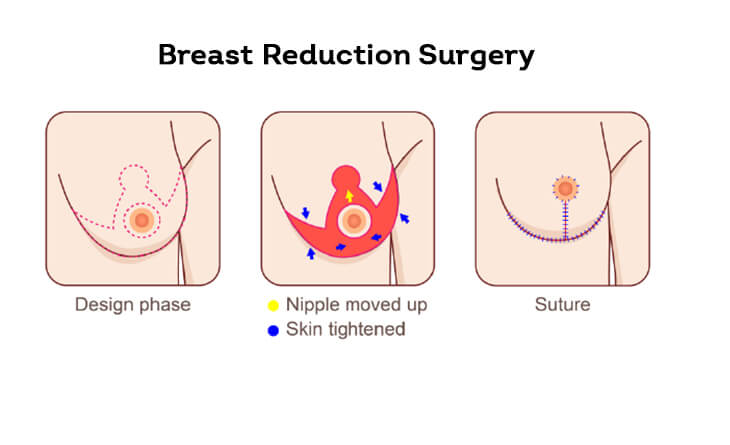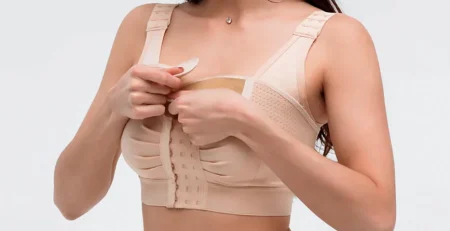What to Expect After Your Breast Reduction Surgery?
Undergoing breast reduction surgery, also known as mastopexy or reduction mammaplasty, is a significant decision that can bring about a positive transformation in a woman’s life. By alleviating the physical discomfort and emotional distress caused by large breasts, breast reduction can enhance overall well-being and self-confidence.
However, as with any surgical procedure, recovery is an essential part of the journey to achieving the desired outcome. In this blog, we will discuss what to expect after the breast reduction surgery.
Let’s get started!
First Few Days After Breast Reduction Surgery
It is common to experience some soreness and discomfort after cosmetic surgery, typically lasting for a few days. It occurs due to the stretching of breast tissues and muscles during the procedure, resulting in bruising and swelling in the breasts and surrounding areas. It could significantly impact the breast reduction surgery cost.
The initial days following surgery are typically the most painful. Your surgeon will usually prescribe pain medication to manage pain levels during this time. After discussing with your surgeon, you can also take over-the-counter pain relievers that can be obtained from a pharmacist.
To minimize swelling, your surgeon may insert drainage tubes into your breasts. This is a standard procedure that expedites the recovery process. These tubes are typically removed within a week.
To avoid prolonging your recovery, you should refrain from any strenuous activities during this period. Additionally, your surgeon may recommend wearing specialized surgical bras to provide support as you heal.
Have questions or want to get started? We are ready to help you with a smile!

Weeks After Breast Reduction Surgery
After a few weeks following breast reduction surgery, you will see a significant reduction in the bruising and swelling you experienced initially. While some discomfort and pain may persist, it should be less intense than in the first few days.
Your stitches are typically removed during this period, and you may no longer need padding or gauze. However, wearing a specialized surgical bra is still advisable to support your breasts during healing.
Most people can return to work at this time as they have recovered sufficiently to handle daily activities. However, the timing of your return depends on your job, lifestyle, and individual needs. If your work is physically demanding, you may require additional recovery before resuming your duties. Otherwise, your overall breast reduction surgery cost can increase.
If you notice increased swelling or pain in the weeks after surgery, seek immediate medical attention. Worsening pain is not a normal part of the healing process and should be investigated.
One Month After Breast Reduction Surgery
While most people experience a full recovery within a month after breast surgery, it’s crucial to continue adhering to your surgeon’s guidelines throughout this period to prevent the risk of infection. During this time, you may notice a gradual softening of your breasts as the swelling subsides and the tissues and muscles heal, leading to a more natural appearance.
Scarring After Breast Reduction Surgery
Many people are hesitant to get breast reduction surgery because of the scars that are left over. However, it is important to remember that scars are usually permanent and even with lasers to reduce their appearance, they tend to be noticeable. When you are looking at pictures of people after breast surgery, try to find ones that have completely recovered.
Right after the surgery, the incisions will be red and angry-looking. This is not how your breasts will look once they heal. Over time, the scars will heal and fade into faint, white lines.
Surgeons also carefully place the incisions in areas where they won’t be as noticeable. So your wardrobe won’t be impacted by your surgery.
The type of breast surgery you have will also influence the appearance of your post-surgical scars. Vertical incisions, for example, heal differently than horizontal ones. You can also choose a scarless breast reduction, which involves two or three little puncture holes rather than incisions while considering breast reduction surgery cost.
Additional Tips for Quick and Smooth Recovery
Here are a few tips that you can follow for a quick and smooth recovery:
Incision Care: Proper incision care prevents infection and promotes optimal healing. Your surgeon will provide specific instructions on cleaning and dressing your incisions. Gently wash the incisions with mild soap and water, pat them dry with a clean towel, and apply fresh dressings as needed.
Dietary and Lifestyle Modifications: A balanced and nutritious diet supports the body’s healing process. Ensure you consume adequate protein, fruits, vegetables, and whole grains. These nutrients provide the building blocks for tissue repair and boost overall health.
Stay Hydrated: Staying hydrated is equally important. Drink plenty of water throughout the day to maintain fluid balance and promote proper circulation. Avoid excessive alcohol consumption, as it can hinder the healing process and impact breast reduction surgery costs.
Managing Activities and Exercise: Gradual activity promotes healing and prevents complications. Short walks around the house can improve blood circulation and reduce the risk of blood clots. However, avoid strenuous activities, lifting heavy objects, or exercising until your surgeon clears.
Your surgeon will provide a timeline for reintroducing exercise into your routine. Typically, you should wait at least 4-6 weeks before resuming any strenuous activities.
Follow-up Appointments: Regular follow-up appointments with your surgeon are crucial for monitoring your progress and addressing any concerns. These visits allow your surgeon to assess your healing, remove surgical drains if necessary, and provide ongoing guidance.
Emotional Well-being: The emotional aspect of recovery after breast reduction surgery is often overlooked but holds significant importance. Understand that recovery takes time, and allow yourself the patience to heal physically and emotionally. Practice self-care techniques such as meditation, yoga, or spending time in nature to promote emotional well-being.
Compression Garments: Compression garments play a vital role in shaping and supporting the breasts during healing. They help reduce swelling, promote proper tissue alignment, and minimize discomfort. Wear the compression garments as instructed by your surgeon, typically for several weeks or months following surgery. Consider the cost of compression garments in overall breast reduction surgery costs.
Book Your Consultation Today!
Breast reduction surgery is significant, but the rewards can be life-changing. Following your surgeon’s instructions, prioritizing rest and self-care, and maintaining a positive outlook, you can navigate the recovery process smoothly and achieve the desired outcome.
If you are considering breast reduction surgery, book your consultation with Dr Lokesh Handa, a board-certified plastic surgeon, today and take the first step in the journey of aesthetic transformation.

Dr. Lokesh Handa
M.S, M.Ch
Sr Consultant Plastic, Aesthetic and
Hair Transplant Surgeon
Dr. Lokesh Handa, a board-certified plastic surgeon with over 15 years of experience, holds esteemed titles of M.S. and M.Ch. He serves as a Senior Consultant in Plastic, Aesthetic, and Hair Transplant Surgery.
As the Director of Med Esthetiks, his commitment to excellence is evident. Dr. Lokesh Handa is a distinguished member of renowned organizations, including ISAPS (International Society of Aesthetic Plastic Surgeons), APSI (Association of Plastic Surgeons of India), and IAAPS (Indian Association of Aesthetic Plastic Surgeons). With extensive expertise, he blends precision and artistry, offering unparalleled care in the realm of plastic surgery and contributing significantly to the advancement of aesthetic practices.
To book an appointment, call: +91-8800203431 or email: care@medesthetiks.com











